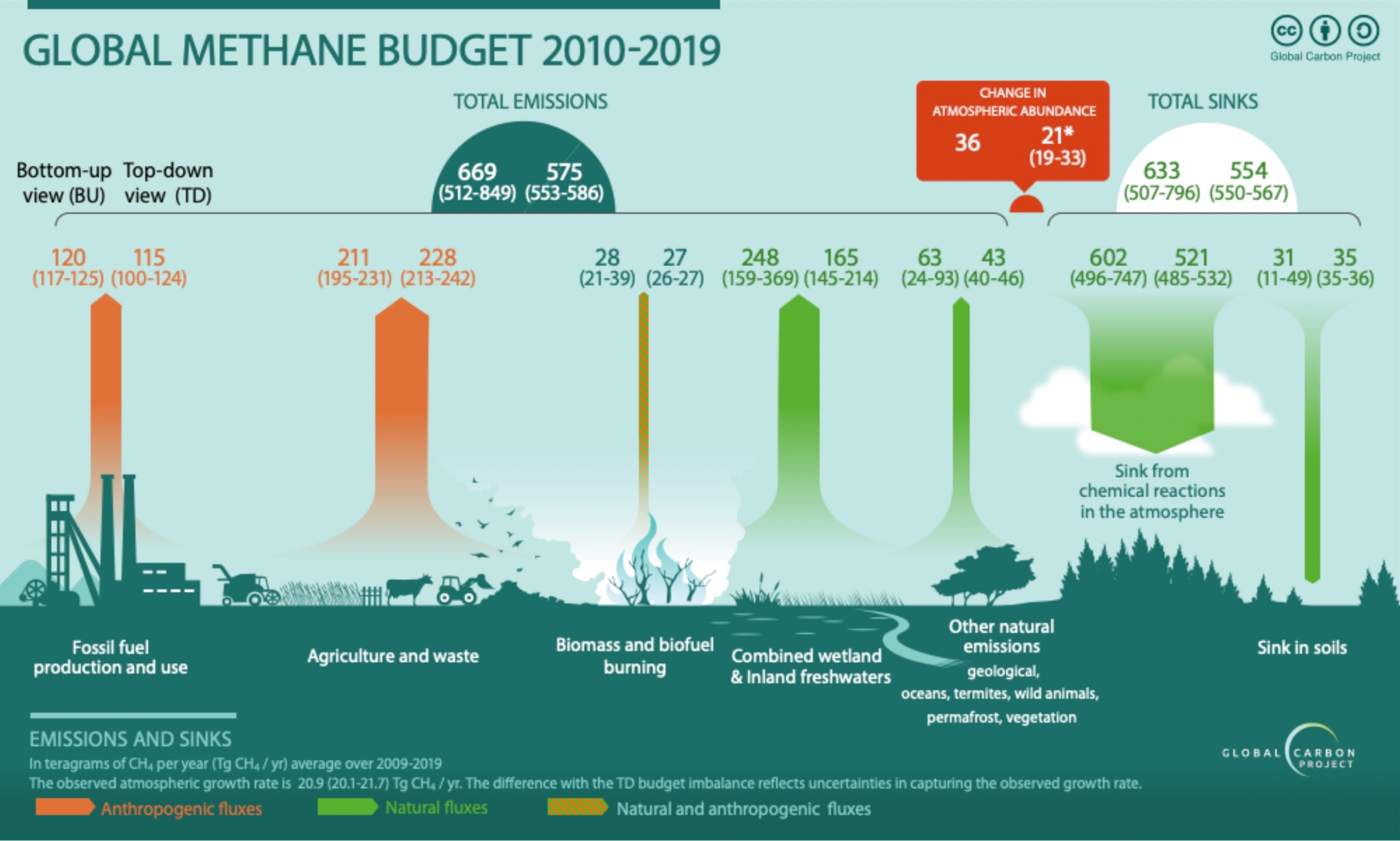
Methane levels are now over 2.5 times higher than pre-industrial levels, contributing around 0.5°C of warming in the 2010s—two-thirds as much as CO₂. Understanding and quantifying the global methane budget is important for assessing realistic pathways to mitigate climate change. A new paper, involving an international team of researchers including CMCC’s Sergio Noce, provides insight on global methane sources and sinks. From the little known role of termites to the costs and benefits of mitigating emissions, the Budget offers a comprehensive view of the geographical regions and economic sectors whose emissions have changed the most since 2000.
Emissions and atmospheric concentrations of methane continue to increase, making it the second most important human-influenced greenhouse gas in terms of climate forcing after carbon dioxide. In fact, methane concentrations have risen faster over the past five-year period than in any period since record-keeping began and yet research suggests that reducing methane emissions may be cheaper than carbon dioxide mitigation for a comparable climate benefit.
The relative importance of methane compared to carbon dioxide for temperature change lies with its shorter atmospheric lifetime, stronger radiative effect, and acceleration in atmospheric growth rate over the past decade. Understanding where and why this acceleration is happening is therefore a central goal of the Global Carbon Project’s Global Methane Budget 2000-2020.
“Keeping track of methane emissions and maintaining a vigilant watch over their trends is crucial for effective climate action,” says CMCC researcher Sergio Noce, one of the co-authors of the latest data description paper on the Global Methane Budget 2000-2020. “Understanding the sources and fluctuations of methane emissions allows us to implement targeted mitigation strategies and monitor their effectiveness. Recent advancements in satellite technology, such as MethaneSAT and CarbonMapper, provide valuable tools for real-time monitoring of methane sources. This can help identify major emitters and enhance our ability to create effective policies.”
With two-thirds of methane emissions attributable to human activities (in particular from fossil fuel exploitation and use, agriculture, and waste handling), it is essential for policymakers and the public to stay informed and engaged in discussions concerning the management of this gas. Careful and continuous monitoring allows for rapid and effective responses which can help reduce impacts on global warming, and hence vital for protecting the environment and ensuring a sustainable future.
“Methane levels are rising quickly, reaching 1,931 parts per billion in January 2024, which is over two and a half times higher than before industrialization,” says Noce, who also highlights that in 2023 global temperatures reached a record high of 1.45°C above pre-industrial levels. “Methane itself has contributed about 0.5°C of warming during the 2010s, accounting for two-thirds of the warming linked to carbon dioxide. The increase in methane concentrations has accelerated significantly in recent years, with large annual rises observed from 2020 to 2023.”
Together with Professor Simona Castaldi, Noce worked on estimating emissions from sources not directly linked to human activities. “These natural methane emissions are particularly significant, accounting for around 35% to 45% of total annual emissions, according to various estimates that make up our updated budget,” says Noce. “Within this broader context, our research focused specifically on termites, that represent a smaller but noteworthy portion of these natural emissions. Despite their small size, these tiny organisms produce a substantial amount of methane through their life processes highlighting their role in the overall methane budget.”
By collaborating with such a multifaceted group of experts from various fields, the project provides a comprehensive understanding of methane emissions, ensuring that the latest findings and methodologies are incorporated into their assessments. This collaborative effort enhances the reliability and accuracy of methane data, enabling better tracking of emissions and informing strategies for mitigation.
The team supporting the recent publication includes approximately 70 experts and combines various methods for methane emission analysis. Furthermore, the innovative aspect of this research, now in its third update, lies in its commitment to keeping global methane emission data up to date. It achieves this by integrating the best available science and data from the scientific community, bringing together key groups that focus on this critical greenhouse gas.
The results highlight not only the significance of methane as a climate influencer but also the need for a unified approach among scientists dedicated to addressing the drivers and impacts of global warming.
For more information:
Saunois, M., Martinez, A., Poulter, B., Zhang, Z., Raymond, P. A., Regnier, P., Canadell, J. G., Jackson, R. B., Patra, P. K., Bousquet, P., Ciais, P., Dlugokencky, E. J., Lan, X., Allen, G. H., Bastviken, D., Beerling, D. J., Belikov, D. A., Blake, D. R., Castaldi, S., Crippa, M., Deemer, B. R., Dennison, F., Etiope, G., Gedney, N., Höglund-Isaksson, L., Holgerson, M. A., Hopcroft, P. O., Hugelius, G., Ito, A., Jain, A. K., Janardanan, R., Johnson, M. S., Kleinen, T., Krummel, P. B., Lauerwald, R., Li, T., Liu, X., McDonald, K. C., Melton, J. R., Mühle, J., Müller, J., Murguia-Flores, F., Niwa, Y., Noce, S., Pan, S., Parker, R. J., Peng, C., Ramonet, M., Riley, W. J., Rocher-Ros, G., Rosentreter, J. A., Sasakawa, M., Segers, A., Smith, S. J., Stanley, E. H., Thanwerdas, J., Tian, H., Tsuruta, A., Tubiello, F. N., Weber, T. S., van der Werf, G. R., Worthy, D. E. J., Xi, Y., Yoshida, Y., Zhang, W., Zheng, B., Zhu, Q., Zhu, Q., and Zhuang, Q.: Global Methane Budget 2000–2020, Earth Syst. Sci. Data, 17, 1873–1958, https://doi.org/10.5194/essd-17-1873-2025, 2025.



